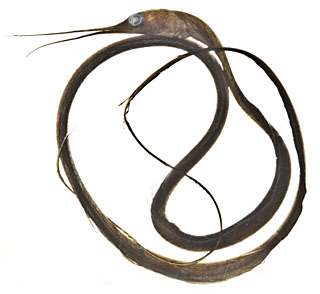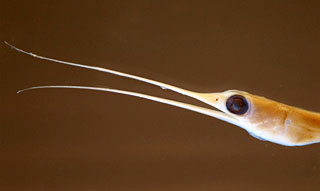
Snipe Eel
Other Names: Slender snipe eel, Threadfish
Scientific Name: Nemichthys scolopaceus
Size Range: Up to 5 feet
Habitat: World wide
Depth Range: Down to 6,000 feet

Snipe Eel
(Nemichthys scolopaceus)
 The snipe eel, known to science as Nemichthys scolopaceus, is a rather peculiar looking fish. It has a long body, up to five feet in length, and resembles a long piece of ribbon or string with a large bulbous head at one end. Its thin body has earned its the nickname, threadfish. Because of its long, bird-like beak, it is sometimes referred to as the deep sea duck. The snipe eel has more vertebrae in its long body than any other animal on Earth. Its spine contains about 750 vertebrae. Its body is so slender that it is actually 75 times as long as it is wide. In spite of the extreme length o fits body, it weighs only a few ounces. Its posterior is so narrow that its ends as a small filament. The snipe eel's anus is actually located on its throat.
The snipe eel, known to science as Nemichthys scolopaceus, is a rather peculiar looking fish. It has a long body, up to five feet in length, and resembles a long piece of ribbon or string with a large bulbous head at one end. Its thin body has earned its the nickname, threadfish. Because of its long, bird-like beak, it is sometimes referred to as the deep sea duck. The snipe eel has more vertebrae in its long body than any other animal on Earth. Its spine contains about 750 vertebrae. Its body is so slender that it is actually 75 times as long as it is wide. In spite of the extreme length o fits body, it weighs only a few ounces. Its posterior is so narrow that its ends as a small filament. The snipe eel's anus is actually located on its throat.

Dried specimen of a snipe eel
(Wikipedia Public Domain Image)
The snipe eel's upper and lower jaws are extremely long and curve away from each other at the tips. This means that they don't meet when the eel closes its mouth. These curved jaws help the eel to catch its food. The jaws are covered with tiny hooked teeth that help capture tiny shrimp and other crustaceans. As the eel swims along with its mouth open, tiny backward-pointing teeth snag the antenna of the shrimp. The shrimp is then worked towards the inside of the mouth and eaten. As is the case with many deep sea species, the snipe eel has proportionally large eyes for its body size. These large eyes help it to gather what little light that manages to penetrate the darkness of the deep sea. The color of the bodyranges from dark brown to gray with fins that are nearly black. The males differ from the females in that as they grow older, their jaws shorten and they lose their teeth. Because of this difference, researchers originally thought that the males and females were actually from different species.

Closeup of a snipe eel showing the long,
curved jaws that resemble a bird's beak
(© opencage / CC BY-SA 2.6)
Very little is known about the reproductive habits of the snipe eel. What is known is that after the eggs are laid by the female, they are fertilized externally by the male. The eggs are buoyant and will float in the water until they hatch. Once hatched, the tiny larvae are shaped like leaves. They will actually shrink in size somewhat before growing larger and becoming adults. It is believed that snipe eels are semelparous, meaning that they mate once and then die immediately. They are thought to have a life span in the wild of about ten years.
The snipe eel is a mid-water fish that is found in open waters at depths of between 300 and 6,000 feet (between 90 and 1,800 meters). The depth varies with latitude. Snipe eels are found in shallower waters at higher latitudes and deeper waters at lower latitudes. Most of what we know about this animal comes from specimens that are caught in fishing trawls. Snipe eels can be found in all of the world's oceans in temperate and tropical regions.
Deep Sea
Creature Database
'



